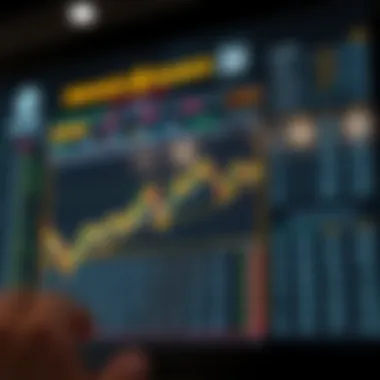Understanding the Binance Order Book for Traders


Intro
The world of cryptocurrency trading can feel like trying to find a needle in a haystack. There's no shortage of complexity, particularly when it comes to understanding the tools that drive investment decisions. Among these tools, the order book on platforms like Binance stands out as a pivotal element. This section aims to shed light on the Binance order book, its workings, and why it plays a crucial role for anyone looking to navigate the crypto markets effectively.
Understanding the order book is essential for traders, both seasoned veterans and novices alike. It displays all the buy and sell orders that market participants have made, reflecting not just the current state of the market but also its potential direction. The bid-ask spread, the depth of the market, and order types are integral components that traders need to grasp.
Diving into this tool offers insights into market sentiment and liquidity—a necessity for any trading strategy. Whether one is looking to enter or exit a position, a solid grasp of how to interpret the order book can substantially impact returns.
In the sections that follow, we’ll explore the current market trends, key indicators, and various investment strategies that can be informed by the dynamics observed in the Binance order book.
Understanding the Order Book Concept
When diving into the world of cryptocurrencies, grasping the concept of the order book is like learning the ABCs of trading. It’s not just a trivial aspect; rather, it's a critical tool for anyone looking to navigate the tumultuous waters of crypto markets, particularly on platforms like Binance. The order book provides a transparent view of the actual supply and demand at any given moment, shaping decisions that can lead to gains or losses.
Understanding the order book helps traders classify their strategies effectively. With various orders put into play, they can decide when to buy or sell, thereby optimizing their trading performance.
"In trading, knowing the order book is akin to knowing the lay of the land; it allows traders to orient themselves quickly."
This concept is fundamental as it unveils the dynamics behind price movements and liquidity in the market. An informed trader taps into this real-time data, making swift decisions based on a blend of quantitative analysis and intuition.
Definition of an Order Book
An order book is a real-time list of buy and sell orders for an asset, detailing the various prices users are willing to accept. In simpler terms, think of it as a market’s pulse, reflecting current trading interests and intentions. On Binance, the order book is constantly updated, mirroring every transaction and user action as they place their bids or asks.
Components of an Order Book
Delving deeper into the components reveals how diversified and layered an order book is, contributing to its effectiveness in the trading landscape. Here are the pivotal elements:
- Buy Orders
Buy orders represent the demand side of the market. Traders use these orders to signify their intent to purchase an asset at specific prices. With a keen understanding of price trends, many investors place limit buy orders, which enable them to buy at a preferred level, should the market permission it. The key characteristic of buy orders is their flexibility; traders can adjust prices based on market conditions, making it a popular choice for many. A unique feature of a buy order includes the capability to execute partially depending on the available volume, which may either advantage or disadvantage the trader based on market fluctuations. - Sell Orders
Conversely, sell orders embody the supply side, displaying how many assets sellers are willing to part with at various prices. Traders often utilize sell orders in tandem with buy orders to execute effective trading strategies. A distinguishing feature of sell orders revolves around their potential impact on price; they can create downward pressure if there’s heavy selling at crowded prices. The flexibility to modify or cancel these orders adds a layer of control for the seller, making this an essential component for anyone keen on optimizing trades. - Market Depth
Market depth refers to the overall volume of buy and sell orders at different price levels. It indicates the liquidity of an asset, showcasing how much could be bought or sold without significantly altering its price. A critical characteristic of market depth is its visualization, often represented in graphs that illustrate the breadth of support and resistance levels. Understanding market depth aids traders in gauging potential price movements. This unique insight can help a trader avoid the pitfalls of thin markets where price may swing dramatically on minimal volume.
Binance Order Book Architecture
Understanding the architecture of the Binance order book is vital for anyone looking to thrive in the cryptocurrency trading arena. It provides a snapshot of market activity, reflecting the current supply and demand for various digital assets. By grasping its fundamental structure, one can make informed trading choices, enhancing their ability to anticipate market shifts.
Structure of the Binance Order Book
The Binance order book consists of two primary elements: buy and sell orders.
- Buy Orders: These are bids from traders willing to purchase a certain quantity of a cryptocurrency at a specified price. Traders often place buy orders at varying price levels to increase their chances of acquisition. The highest buy order represents the maximum price that a buyer is willing to pay.
- Sell Orders: Conversely, sell orders are offers from traders looking to sell their cryptocurrency at a particular price. The lowest sell order indicates the minimum price a seller is prepared to accept for their asset.
This structure gives a clear picture of the market's liquidity and helps to establish the current market price. The prominent orders are displayed, with the best bid and offer visible for rapid assessments.
In essence, the architecture allows traders to visualize the competitive landscape quickly. New traders often get a clearer sense of market sentiment just by glancing at the order book, as it reflects real-time activity and trader intentions.
Real-time Data Updates
One of the standout features of the Binance order book is its ability to provide real-time data updates. This is crucial in a market that moves at lightning speed. Here’s how it works:
- Continuous Refresh: The Binance platform continually refreshes the order book to ensure traders have the latest information. This means that as new buy and sell orders are placed, the data reflects those changes instantly.
- Order Matching: Orders are matched in real-time, which means that trades can occur quickly. A spike in buy orders can lead to a rapid price change if immediate sell orders are present. Traders must be alert, as conditions can shift in a heartbeat.
- Market Depth: The depth of the market, which refers to the ability to absorb large orders without significantly impacting the price, becomes evident through these updates. A healthy order book with numerous buy and sell orders at varying price levels suggests good market depth—an attractive condition for traders.
This ability to monitor fluctuations in real-time not only aids in short-term trading strategies but also supports long-term analysis of price trends and market behavior. Traders who fail to tap into real-time updates risk being blindsided by sudden market changes.
In summary, both the structure and real-time data updates of the Binance order book offer traders an invaluable resource for understanding market dynamics. They provide the framework necessary for implementing effective trading strategies and making informed decisions.
The Role of the Order Book in Trading
The order book plays a pivotal role in the realm of trading, especially in a market as volatile and dynamic as cryptocurrency. It acts as a central hub where buying and selling transactions occur, representing the collective interests of all active traders. Understanding the order book can enhance a trader's decision-making process and improve their overall strategy.


In this section, we will unpack the mechanics behind the order book's involvement in trading, emphasizing key elements such as its influence on price discovery, liquidity provision, and the impact various order types can have on trading outcomes.
Price Discovery Mechanism
One of the primary functions of the order book is its role in the price discovery process. Price discovery refers to the way the market determines the price of an asset through supply and demand dynamics. The order book reflects these dynamics in real time. Orders are listed at the price points where buyers are willing to purchase and sellers are ready to offload their assets.
For instance, if there's high demand for Bitcoin at a specific price level but limited supply, this imbalance propels the price upward. Conversely, if more sellers emerge and the supply outpaces demand, the price declines. This balancing act is ongoing and directly observable in the order book as traders adjust their strategies based on their individual analyses.
Furthermore, the transparency that comes with having an accessible order book creates a more informed trading environment, allowing both novices and experts to gauge market sentiment efficiently.
Liquidity Provision
Liquidity is a crucial component in any trading market, and the order book serves as a vital facilitator of liquidity. A liquid market is one where assets can be bought or sold quickly with minimal impact on the price. The presence of a diverse range of orders improves liquidity.
In the Binance order book, if there are numerous buy and sell orders across various price levels, traders can execute their trades without significant slippage. For example, when a trader wishes to sell their holdings quickly, having ample buyers at or near their desired price ensures that a trade can occur without substantial delay or price distortion.
In essence, a well-populated order book not only fosters liquidity but also encourages participants to trade more confidently, knowing their orders are likely to get filled rapidly.
Impact of Order Types
When it comes to the practical aspect of trading, understanding different order types is paramount. The Binance order book supports several order types, each with its unique characteristics and implications.
Limit Orders
Limit orders allow traders to specify the price at which they want to buy or sell an asset. This gives them control over execution price but comes at the cost of speed: an order may not fill immediately, especially in fast-moving markets. Many traders favor limit orders for their precision, reducing the chance of sudden slippage that can occur with other order types.
Unique benefits of limit orders:
- Control over price: Traders can set parameters that align with their trading strategies.
- Cost efficiency: They help avoid unfavorable prices by letting traders wait for favorable market conditions.
However, on the flip side, there's a risk of missing out on trades in a quickly shifting market if prices never reach the limit set.
Market Orders
Market orders are executed immediately at the current market price. They are straightforward and are favored for their speed – ideal in situations where timing is critical, such as during a sudden market downturn.
Key characterization of market orders:
- Immediate execution: Perfect for quick buys or sells, especially in volatile markets.
- Simplicity: They require no extensive analysis before placement.
While market orders guarantee execution, they come with the potential downside of slippage, particularly during high volatility, where the price might differ from what was expected when placing the order.
Stop-Loss Orders
Stop-loss orders are strategically used to minimize losses. They are placed to sell an asset once it reaches a certain price, helping traders limit downside risk. This type of order is popular among cautious traders looking to protect their investments.
Notable features of stop-loss orders include:
- Risk management: They are intrinsically linked to a trader's risk appetite, providing an automatic mechanism to sell if things go south.
- Less emotion involved: They serve as a premeditated plan, removing emotional decision-making from trading.
However, if market conditions are highly chaotic, stop-loss orders can be executed at prices worse than expected, commonly referred to as
Analyzing Order Book Data
Diving into the nitty-gritty of the order book, particularly in the context of Binance, is crucial for traders seeking a competitive edge. Understanding this data meticulously can unveil patterns, trends, and market sentiment that might otherwise fly under the radar. For both novice and seasoned traders, the analysis of order book data serves as a compass in the unpredictable seas of cryptocurrency trading. It enables them to make informed decisions, adapt strategies rapidly, and ultimately, improve their odds of success.
Order Book Heatmap


A heatmap represents the order book visually, displaying the concentration of buy and sell orders across various price levels. This visual tool is as handy as a Swiss army knife, attracting attention for its ease of use and comprehensible layout. With the heatmap, traders can identify key support and resistance levels clearly, acting as the spine of their trading strategies.
- Red Areas: These typically signify a high concentration of sell orders. A notable red zone often keeps buyers at bay, manifested as a potential ceiling for prices.
- Green Areas: Conversely, they reveal the hotspots for buying interest. A strong green zone suggests buyers are eager, potentially pushing prices upwards.
In practice, a trader might spot a buildup of sell orders near a particular price point. Recognizing this could prompt them to adjust their buying strategy—either entering earlier or waiting for a more opportune moment.
"A heatmap is like a pulse of the market, showing where traders' interests lie."
The practical application of heatmap data can be game-changing. It assists in evaluating when to execute trades and when to hold back, crucial for optimizing profit margins.
Understanding Order Flow
Order flow analysis entails tracking how orders are placed and filled in real-time, providing insight into buying and selling pressure at any moment. Instead of merely observing static numbers, order flow analysis ventures deeper into how market conditions shift dynamically—an essential aspect in high-frequency trading environments.
Key Factors Include:
- Volume: High volume often indicates strong conviction behind price movements, whether bullish or bearish, reflecting traders’ sentiment.
- Speed: The time it takes for orders to be filled can signal underlying market health. A rapid influx of orders may suggest increased activity or impending volatility.
- Execution: Noting the types of orders being filled can help traders discern whether the market is favoring buyers or sellers at any given time.
Utilizing tools like trade volume indicators can help decipher these elements. By recognizing when many buy orders are filled compared to sell orders, traders can gauge market momentum.
Ultimately, a keen eye on order flow empowers traders. It reveals the real-time narrative of the market, enabling them to react swiftly, whether it be to double down on a position or pull back entirely. Keeping an ear to the ground in terms of order flow is akin to having an insider's perspective on market movements, a vantage point that could make all the difference in trading outcomes.
Strategies Leveraging the Order Book
Understanding how to effectively utilize the Binance order book can be a game changer for traders looking to sharpen their strategies. The order book is not merely a data collection of buy and sell orders but a dynamic tool that offers insights into market behavior. By leveraging these insights, traders can enhance their decision-making processes and refine their trading tactics.
Scalping using Order Book Insights
Scalping involves executing numerous trades within a short time frame, aiming to capitalize on little price movements. Traders who are skilled in reading the order book can identify patterns that inform their scalping strategies. For instance, observing the levels where buy and sell orders stack up can reveal potential support and resistance zones. If buy orders significantly outweigh sell orders at a certain price, traders might see it as a prime entry point. Conversely, a surge in sell orders can signify impending downward pressure.
One approach scalpers might employ is to watch the order book for significant volume spikes. If they notice a large sell order emerging, they might decide to either exit a long position or short the coin. Similarly, they can look for patterns in order cancellations—a sudden drop in sell orders might indicate that buyers are gaining strength.
- Key Considerations for Scalping:
- Speed is crucial: Be ready to execute trades rapidly based on order book changes.
- Understand potential pitfalls: Prices can shift unexpectedly, so have a stop-loss in place.
- Practice risk management: The frequency of trades means potential losses can accumulate quickly.
Arbitrage Opportunities
Arbitrage is another effective tactic that can benefit from the insights drawn from the order book. Essentially, arbitrage relies on price discrepancies between different exchanges. A trader can exploit these inequalities by buying a cryptocurrency on one platform at a lower price and selling it on another at a higher price. To identify these opportunities, an in-depth analysis of order book data across exchanges is vital.
For example, if a cryptocurrency is trading at $100 on Binance but $105 on another exchange, a savvy trader will check the order books. If the order books reveal sufficient liquidity, the trader can execute a buy order on Binance and an immediate sell order on the other exchange, pocketing the difference.
- Important Aspects of Arbitrage to Remember:
- Timing: Price discrepancies can close rapidly, making speed essential to realize profits.
- Transaction Costs: Fees associated with trading can erode potential gains, so always calculate net profits.
- Market Depth: Ensure there is enough liquidity to execute orders at the desired price without causing significant slippage.
By mastering the intricacies of the Binance order book, traders can better navigate the turbulent waters of cryptocurrency trading. Both scalping and arbitrage highlight the blend between analytical skills and pragmatic market understanding, ultimately leading to more informed trading decisions.
Challenges with Binance Order Book
The Binance order book, while a powerful tool for traders, is not without its challenges. Understanding these hurdles is crucial for anyone navigating the treacherous waters of crypto trading. Key aspects of market manipulation risks and the effects of high volatility are fundamental considerations that can impact trading strategies significantly. The consequences of ignoring these risks can be detrimental, leading to unexpected losses or missed opportunities. Traders need to be acutely aware of these challenges in order to maintain a robust trading strategy.
Market Manipulation Risks
Market manipulation refers to actions designed to deceive or mislead traders in the market. Unfortunately, the anonymity and accessibility of cryptocurrency trading platforms, like Binance, can enable such practices to occur with relative ease. Here are a few facets to consider:
- Spoofing and Layering: Traders may place large orders that they have no intention of executing, simply to create a false sense of market demand or supply. This can lead unsuspecting traders to enter positions that might not have been pursued had the true market conditions been clear.
- Wash Trading: This involves a trader or group of traders buying and selling the same asset to inflate trading volume artificially. It’s akin to a smoke and mirrors show, creating the illusion of activity where there is none.
- Pump and Dump Schemes: A classic tactic where promoters enhance the image of a specific cryptocurrency, leading to a spike in price. Once the price reaches a certain point, they sell off their holdings, leaving less knowledgeable investors holding the bag when the price collapses.


As a result, traders need to scrutinize order book activity carefully, looking for signs of manipulation to protect themselves from deceptive practices. Educating oneself about these risks is as imperative as understanding technical analysis.
"In the world of trading, the ability to spot red flags can be the difference between a savvy investor and a casualty of the market."
High Volatility Effects
The crypto market is notoriously volatile. Price fluctuations can be sudden and severe, influenced by numerous factors ranging from market sentiment and regulatory news to macroeconomic events. The effects of this volatility present real challenges in trading:
- Slippage: This occurs when a trade is executed at a different price than expected. In fast-moving markets, orders may not fill at the anticipated price, especially during periods of high volatility. Traders must account for slippage when placing trades, particularly with larger orders.
- Emotional Trading: High volatility can lead to heightened emotions. Traders might make impulsive decisions based on fear or greed. A disciplined approach is essential to navigate these turbulent times.
- Liquidity Issues: In highly volatile segments, liquidity can dry up faster than a desert well. During a price crash or spike, traders may find it difficult to execute trades at their desired prices due to lack of buyers or sellers. This could lead to significant losses if one is not careful.
In light of these challenges, it’s imperative for traders to develop a sound risk management strategy that accounts for both market manipulation and volatility. Tools such as stop-loss orders and clear trend analysis can offer some measure of protection in an unpredictable environment.
Future of Order Books in Crypto Trading
With the exponential growth of cryptocurrency and its increasing integration into the mainstream financial system, the future of order books stands as a pivotal topic. Order books are more than just digital ledgers; they represent the heartbeat of trading platforms and dictate how transactions flow in and out of the market. In analyzing the future of order books, we uncover significant technological advancements, potential regulatory frameworks, and strategic benefits that will shape the trading landscape moving forward. Understanding these aspects can greatly inform trading strategies and investment decisions for seasoned traders and newcomers alike.
Technological Innovations
As the crypto space continues to evolve, technological innovations have emerged to enhance the efficiency and efficacy of order books. One of the key trends includes the integration of artificial intelligence (AI) and machine learning. With these technologies, platforms can analyze vast amounts of trading data in real-time. This enables them to identify patterns, predict market moves, and adjust algorithms dynamically—this is critical when traders are looking for that elusive edge in a crowded market.
Additionally, blockchain advancements, such as Layer 2 solutions, can drastically improve transaction speeds and reduce costs on trading platforms like Binance. This further optimizes the order book's function, allowing smoother transactions and reduced slippage during volatile market conditions.
Other noteworthy innovations involve the adoption of decentralized finance (DeFi) principles. Decentralized order books can reduce reliance on centralized exchanges, offering greater transparency and security for users. By facilitating trades without intermediaries, they lower fees and expand access for traders around the globe.
"The integration of cutting-edge technology into the order book structure is set to revolutionize how trading occurs in the crypto realm, enabling more robust and efficient trading experiences."
- Data Centralization and Transparency: Enhanced visibility into the order book also promises an improvement in trader confidence. New protocols are enabling clearer views of liquidity and order execution, thereby reducing instances of manipulation or errors, which enhances the trading experience.
Regulatory Considerations
As the future of order books progresses, regulatory considerations loom large. Governments and regulatory bodies are becoming increasingly aware of the necessity to construct frameworks that govern cryptocurrency trading. This is crucial for fostering investor confidence and ensuring a safe trading environment.
A potential focus area is the harmonization of regulations across different jurisdictions. As cryptocurrencies cross borders, a patchwork of rules can pose challenges for global trading. Streamlined regulations could offer clarity and assurance, particularly concerning anti-money laundering (AML) and know your customer (KYC) guidelines, which could drastically affect how traders interact with order books.
Furthermore, regulatory clarity around reporting requirements is necessary. As order book transactions grow in volume and complexity, regulators may require platforms to maintain detailed transaction records, which could enhance market integrity.
However, there is a balancing act at play. Regulation aims to protect investors and ensure fairness without stifling innovation. For players in the crypto space, adaptability and foresight will be critical as they navigate these evolving regulatory landscapes.
For those engaged in crypto trading, staying informed about legislative developments and understanding the implications of these regulations on order books is paramount. This knowledge can serve as a strategic advantage in ensuring compliance while optimizing trading performance.
In Summary
The future of order books in crypto trading is interlaced with technological advancements and regulatory adjustments. As traders, analysts, and investors, having a grasp of these components will empower decision-making. Whether it’s leveraging AI for market insights or remaining aware of shifting regulatory tides, successful navigation of the changing landscape is vital for thriving in cryptocurrency trading.
Culmination and Key Takeaways
In wrapping up our exploration of the Binance order book, it’s essential to underline the critical role it plays in the landscape of cryptocurrency trading. The order book serves as a visible manifestation of market sentiment, reflecting real-time buyer and seller intentions. Without a doubt, grasping the intricacies of the order book allows traders to make informed decisions that can directly influence their profitability.
Summarizing the Importance of the Order Book
The importance of the order book cannot be overstated. First and foremost, it acts as a heartbeat of the trading platform. Traders look at the order book to gauge where liquidity resides, enabling them to assess the market’s depth at various price levels.
- Execution of Trades: The order book determines how trades are executed, particularly in fast-moving markets. A thorough understanding will help traders time their entries and exits perfectly.
- Market Trends: By visualizing buy and sell orders, traders can identify trends and potential reversals. This supports better strategic positioning.
- Risk Management: Analyzing the order flow and depth can assist in making risk-aware decisions. It provides insights into potential price volatility that may arise from large sell-offs or buy-ups.
Ultimately, keeping a close eye on the order book translates to having an edge over market moves.
Encouraging Informed Trading Practices
Incentivizing a disciplined approach to trading is key. Knowledge empowers. By interpreting order book data judiciously, traders can eschew impulsive actions and instead, cultivate a methodical trading strategy. Here are a few practices to enhance decision-making:
- Continuous Learning: Stay updated on market conditions, order book dynamics, and technological innovations. Resources like Investopedia and CoinDesk can provide valuable insights.
- Utilize Tools: Using analytical tools can help visualize market data effectively. Platforms like TradingView or Binance’s own layout can be instrumental.
- Practice Patience: Real-time analysis demands patience. Waiting for the right moment often delineates successful traders from those who fail.
By committing to informed trading practices, one doesn’t just navigate the order book; they also chart a course toward sustained success in cryptocurrency trading.
"A wise trader doesn’t just see the order book; they read it like a map to opportunity."















